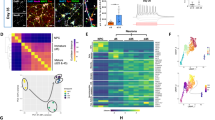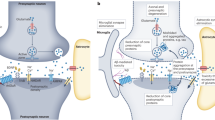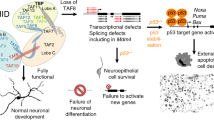Abstract
p53 plays a central role in neuronal cell death resulting from acute injury or disease. To define the pathway by which p53 triggers apoptosis, we used microarray analysis to identify p53 target genes specifically upregulated during apoptosis but not cell cycle arrest. This analysis identified a small subset of targets highly selective for the p53 apoptotic response, including Siva, a proapoptotic protein whose function is not well understood. Siva's expression pattern suggests that it plays an instructive role in apoptosis, and accordingly, we demonstrate that Siva is essential for p53-dependent apoptosis in cerebellar granule neurons. In addition, we determine that endogenous Siva is associated with the plasma membrane and that Caspase-8 and Bid are important for neuronal apoptosis. Our studies highlight the participation of membrane signaling events in p53's apoptotic program in primary neurons and have significant implications for understanding the mechanisms underlying pathogenesis after neuronal injury and in neurodegenerative diseases.
Similar content being viewed by others
Log in or create a free account to read this content
Gain free access to this article, as well as selected content from this journal and more on nature.com
or
Accession codes
Abbreviations
- MEFs:
-
mouse embryonic fibroblasts
- E1A-MEFs:
-
E1A-expressing MEFs
- dChip:
-
DNA-Chip analyzer
- Perp:
-
p53 effector of apoptosis related to Pmp22
- Nm23-M4:
-
expressed in non-metastatic cells 4
- Daf-1:
-
decay accelerating factor-1
- Gtse:
-
G two S phase expressed protein 1
- Apaf-1:
-
apoptotic protease activating factor-1
- CGN:
-
cerebellar granule neurons
- DIV:
-
days in vitro
- shRNAs:
-
short hairpin RNAs
- EGFR:
-
epidermal growth factor receptor
- TNF:
-
tumor necrosis factor
- S.E.M.:
-
standard error of the mean
References
Vousden KH, Lu X . Live or let die: the cell's response to p53. Nat Rev Cancer 2002; 2: 594–604.
Morrison RS, Kinoshita Y, Johnson MD, Guo W, Garden GA . p53-dependent cell death signaling in neurons. Neurochem Res 2003; 28: 15–27.
Bae BI, Xu H, Igarashi S, Fujimuro M, Agrawal N, Taya Y et al. p53 mediates cellular dysfunction and behavioral abnormalities in Huntington's disease. Neuron 2005; 47: 29–41.
Culmsee C, Mattson MP . p53 in neuronal apoptosis. Biochem Biophys Res Commun 2005; 331: 761–777.
Duan W, Zhu X, Ladenheim B, Yu QS, Guo Z, Oyler J et al. p53 inhibitors preserve dopamine neurons and motor function in experimental parkinsonism. Ann Neurol 2002; 52: 597–606.
Culmsee C, Zhu X, Yu QS, Chan SL, Camandola S, Guo Z et al. A synthetic inhibitor of p53 protects neurons against death induced by ischemic and excitotoxic insults, and amyloid beta-peptide. J Neurochem 2001; 77: 220–228.
Leker RR, Aharonowiz M, Greig NH, Ovadia H . The role of p53-induced apoptosis in cerebral ischemia: effects of the p53 inhibitor pifithrin alpha. Exp Neurol 2004; 187: 478–486.
Chao C, Saito S, Kang J, Anderson CW, Appella E, Xu Y . p53 transcriptional activity is essential for p53-dependent apoptosis following DNA damage. EMBO J 2000; 19: 4967–4975.
Johnson TM, Hammond EM, Giaccia A, Attardi LD . The p53QS transactivation-deficient mutant shows stress-specific apoptotic activity and induces embryonic lethality. Nat Genet 2005; 37: 145–152.
Ihrie RA, Reczek E, Horner JS, Khachatrian L, Sage J, Jacks T et al. Perp is a mediator of p53-dependent apoptosis in diverse cell types. Curr Biol 2003; 13: 1985–1990.
Jeffers JR, Parganas E, Lee Y, Yang C, Wang J, Brennan J et al. Puma is an essential mediator of p53-dependent and -independent apoptotic pathways. Cancer Cell 2003; 4: 321–328.
McCurrach ME, Connor TM, Knudson CM, Korsmeyer SJ, Lowe SW . Bax-deficiency promotes drug resistance and oncogenic transformation by attenuating p53-dependent apoptosis. Proc Natl Acad Sci USA 1997; 94: 2345–2349.
Shibue T, Takeda K, Oda E, Tanaka H, Murasawa H, Takaoka A et al. Integral role of Noxa in p53-mediated apoptotic response. Genes Dev 2003; 17: 2233–2238.
Villunger A, Michalak EM, Coultas L, Mullauer F, Bock G, Ausserlechner MJ et al. p53- and drug-induced apoptotic responses mediated by BH3-only proteins puma and noxa. Science 2003; 302: 1036–1038.
Attardi LD, Reczek EE, Cosmas C, Demicco EG, McCurrach ME, Lowe SW et al. PERP, an apoptosis-associated target of p53, is a novel member of the PMP-22/gas3 family. Genes Dev 2000; 14: 704–718.
Lowe SW, Ruley HE . Stabilization of the p53 tumor suppressor is induced by adenovirus 5 E1A and accompanies apoptosis. Genes Dev 1993; 7: 535–545.
Debbas M, White E . Wild-type p53 mediates apoptosis by E1A, which is inhibited by E1B. Genes Dev 1993; 7: 546–554.
Soengas MS, Alarcon RM, Yoshida H, Giaccia AJ, Hakem R, Mak TW et al. Apaf-1 and caspase-9 in p53-dependent apoptosis and tumor inhibition. Science 1999; 284: 156–159.
Prasad KV, Ao Z, Yoon Y, Wu MX, Rizk M, Jacquot S et al. CD27, a member of the tumor necrosis factor receptor family, induces apoptosis and binds to Siva, a proapoptotic protein. Proc Natl Acad Sci USA 1997; 94: 6346–6351.
Masse K, Dabernat S, Bourbon PM, Larou M, Amrein L, Barraud P et al. Characterization of the nm23-M2, nm23-M3 and nm23-M4 mouse genes: comparison with their human orthologs. Gene 2002; 296: 87–97.
Mikesch JH, Buerger H, Simon R, Brandt B . Decay-accelerating factor (CD55): a versatile acting molecule in human malignancies. Biochim Biophys Acta 2006; 1766: 42–52.
Fortin A, MacLaurin JG, Arbour N, Cregan SP, Kushwaha N, Callaghan SM et al. The proapoptotic gene SIVA is a direct transcriptional target for the tumor suppressors p53 and E2F1. J Biol Chem 2004; 279: 28706–28714.
Yonish-Rouach E, Resnitzky D, Lotem J, Sachs L, Kimchi A, Oren M . Wild-type p53 induces apoptosis of myeloid leukaemic cells that is inhibited by interleukin-6. Nature 1991; 352: 345–347.
Enokido Y, Araki T, Tanaka K, Aizawa S, Hatanaka H . Involvement of p53 in DNA strand break-induced apoptosis in postmitotic CNS neurons. Eur J Neurosci 1996; 8: 1812–1821.
Cory S, Adams JM . The Bcl2 family: regulators of the cellular life-or-death switch. Nat Rev Cancer 2002; 2: 647–656.
Py B, Slomianny C, Auberger P, Petit PX, Benichou S . Siva-1 and an alternative splice form lacking the death domain, Siva-2, similarly induce apoptosis in T lymphocytes via a caspase-dependent mitochondrial pathway. J Immunol 2004; 172: 4008–4017.
Xue L, Chu F, Cheng Y, Sun X, Borthakur A, Ramarao M et al. Siva-1 binds to and inhibits BCL-X(L)-mediated protection against UV radiation-induced apoptosis. Proc Natl Acad Sci USA 2002; 99: 6925–6930.
Herzog KH, Chong MJ, Kapsetaki M, Morgan JI, McKinnon PJ . Requirement for Atm in ionizing radiation-induced cell death in the developing central nervous system. Science 1998; 280: 1089–1091.
Plesnila N, Zinkel S, Le DA, Amin-Hanjani S, Wu Y, Qiu J et al. BID mediates neuronal cell death after oxygen/glucose deprivation and focal cerebral ischemia. Proc Natl Acad Sci USA 2001; 98: 15318–15323.
Fortin A, Cregan SP, MacLaurin JG, Kushwaha N, Hickman ES, Thompson CS et al. APAF1 is a key transcriptional target for p53 in the regulation of neuronal cell death. J Cell Biol 2001; 155: 207–216.
Xiang H, Kinoshita Y, Knudson CM, Korsmeyer SJ, Schwartzkroin PA, Morrison RS . Bax involvement in p53-mediated neuronal cell death. J Neurosci 1998; 18: 1363–1373.
Spinicelli S, Nocentini G, Ronchetti S, Krausz LT, Bianchini R, Riccardi C . GITR interacts with the pro-apoptotic protein Siva and induces apoptosis. Cell Death Differ 2002; 9: 1382–1384.
Chu F, Barkinge J, Hawkins S, Gudi R, Salgia R, Kanteti PV . Expression of Siva-1 protein or its putative amphipathic helical region enhances cisplatin-induced apoptosis in breast cancer cells: effect of elevated levels of BCL-2. Cancer Res 2005; 65: 5301–5309.
Semont A, Nowak EB, Silva Lages C, Mathieu C, Mouthon MA, May E et al. Involvement of p53 and Fas/CD95 in murine neural progenitor cell response to ionizing irradiation. Oncogene 2004; 23: 8497–8508.
Finnberg N, Gruber JJ, Fei P, Rudolph D, Bric A, Kim SH et al. DR5 knockout mice are compromised in radiation-induced apoptosis. Mol Cell Biol 2005; 25: 2000–2013.
Michalak E, Villunger A, Erlacher M, Strasser A . Death squads enlisted by the tumour suppressor p53. Biochem Biophys Res Commun 2005; 331: 786–798.
Yin XM, Wang K, Gross A, Zhao Y, Zinkel S, Klocke B et al. Bid-deficient mice are resistant to Fas-induced hepatocellular apoptosis. Nature 1999; 400: 886–891.
Mattson MP . Apoptosis in neurodegenerative disorders. Nat Rev Mol Cell Biol 2000; 1: 120–129.
Chung CH, Parker JS, Karaca G, Wu J, Funkhouser WK, Moore D et al. Molecular classification of head and neck squamous cell carcinomas using patterns of gene expression. Cancer Cell 2004; 5: 489–500.
Attardi LD, Lowe SW, Brugarolas J, Jacks T . Transcriptional activation by p53, but not induction of the p21 gene, is essential for oncogene-mediated apoptosis. EMBO J 1996; 15: 3693–3701.
Bonni A, Brunet A, West AE, Datta SR, Takasu MA, Greenberg ME . Cell survival promoted by the Ras-MAPK signaling pathway by transcription-dependent and -independent mechanisms. Science 1999; 286: 1358–1362.
Rubinson DA, Dillon CP, Kwiatkowski AV, Sievers C, Yang L, Kopinja J et al. A lentivirus-based system to functionally silence genes in primary mammalian cells, stem cells and transgenic mice by RNA interference. Nat Genet 2003; 33: 401–406.
Vogelmann R, Nelson WJ . Fractionation of the epithelial apical junctional complex: reassessment of protein distributions in different substructures. Mol Biol Cell 2005; 16: 701–716.
Acknowledgements
We are grateful to Anne Brunet, Julien Sage, Tom Johnson, Rebecca Ihrie, Steven Artandi, and Amato Giaccia for helpful comments and critical reading of the paper. We thank Jim Brown for assistance with dChip analysis, Roger Vogelmann for assistance with the iodixanol gradients, and Anne Brunet for help with neuronal preparations and lentiviral infections. The Bax−/− Bak−/− MEFs and Bid−/− mice were kindly provided by Craig Thompson and Stanley Korsmeyer, respectively. The EGFR, Na+K+ ATPase, Bid, and Caspase-8 antibodies were provided by Suzanne Pfeffer, W James Nelson, David Huang, and Matthew Bogyo, respectively. This work was supported by the NCI (PHS Grant Number CA09302-27) and Giannini Family Foundation to SBRJ, the Susan G Komen Foundation to SB, a Howard Hughes Medical Institute pre-doctoral fellowship to JIM, and the Damon Runyon Cancer Research Foundation and the Donald E and Delia B Baxter Foundation to LDA.
Author information
Authors and Affiliations
Corresponding author
Additional information
Edited by V De Laurenzi
Supplementary Information accompanies the paper on Cell Death and Differentiation website (http://www.nature.com/cdd)
Rights and permissions
About this article
Cite this article
Jacobs, S., Basak, S., Murray, J. et al. Siva is an apoptosis-selective p53 target gene important for neuronal cell death. Cell Death Differ 14, 1374–1385 (2007). https://doi.org/10.1038/sj.cdd.4402128
Received:
Revised:
Accepted:
Published:
Issue date:
DOI: https://doi.org/10.1038/sj.cdd.4402128
Keywords
This article is cited by
-
Siva plays a critical role in mouse embryonic development
Cell Death & Differentiation (2020)
-
SIVA-1 regulates apoptosis and synaptic function by modulating XIAP interaction with the death receptor antagonist FAIM-L
Cell Death & Disease (2020)
-
Siva1 inhibits p53 function by acting as an ARF E3 ubiquitin ligase
Nature Communications (2013)
-
The PMP22 Gene and Its Related Diseases
Molecular Neurobiology (2013)
-
Multifaceted functions of Siva-1: more than an Indian God of Destruction
Protein & Cell (2012)



